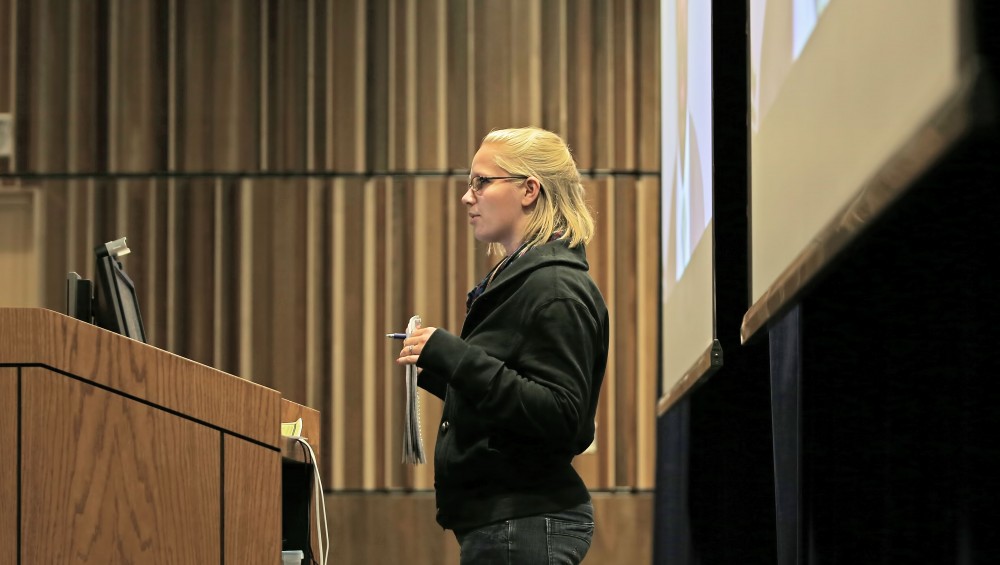Bridging the gap

GVL/Kevin Sielaff White House Skype Session with Marco Davis. (Hailie Roblyer)
Oct 9, 2014
Marcos Davis, the deputy director for the White House Initiative on Educational Excellence for Hispanics, gave a Skype presentation called “Creating Initiatives for Latino Students to Succeed in Education” in the Mary Idema Pew Library on Tuesday.
Davis said the initiative first emerged as an executive order in 1990 to find ways to increase opportunities in education, focusing on how to raise awareness about the challenges many Latinos face in higher education.
“A lot of what we do is highlight issues, both in the mainstream media and Latino media,” he said. “We find that folks don’t have as much information as we’d like them to have. We want to advance the dialogue and demonstrate that we can overcome problems by taking advantage of the solutions.”
He said the initiative works in seven areas – early childhood education, STEM education, Hispanic teacher recruitment, college access, post-secondary completion, family engagement and the My Brother’s Keeper project – in order to allow everyone to succeed.
“The future of our nation is inextricably linked to the future of our Latino community,” Davis said. “We want to ensure that we have a strong, well-educated, competitive Latino community in the schools and in the workforce, which will ultimately benefit our economy and our global competitiveness as a nation.”
In addition to the high school dropout rate, Davis said one of the biggest problems is the low retention rate among Latino students. Only 14 percent of Latinos age 25 or older have at least a bachelor’s degree.
“There’s an issue here,” Davis said. “There’s something to be concerned about.”
Despite this, the number of Latino students who have graduated high school and immediately enrolled in college has increased, which Davis says is promising.
Davis said the initiative is developing a mentoring pipeline to help guide minority students who want to become teachers. He said jobs are growing the fastest in STEM fields, though only 8 percent of Latinos graduated with STEM degrees in 2010.
“We need, as American students, to be much more knowledgeable and comfortable and able to take advantage of those topics,” Davis said. “We want to make sure people know about the STEM fields, especially in Latino communities.”
Natalia Gómez, a GVSU Spanish professor, facilitated the Skype event. Gomez said she wanted to help raise awareness about the challenges underrepresented populations face in higher education.
“Unfortunately the number of Latino students that enroll and finish a college degree is still very low,” she said. “So we need to expose the Latino community with any opportunities available to understand the real significance of pursing higher education degrees in diverse fields.”
Gomez said she and Mayra Fortes González, a GVSU assistant Spanish professor, discussed the need to bring someone who could speak about the government’s initiatives to campus.
“I knew about the efforts of the White House Initiative on Educational Excellence for Hispanics, so I proposed to bring to campus Marcos A. Davis,” Gomez said. “We also organized this talk around Hispanic Heritage month.”
The Latina Student Initiative, Latina Faculty and Staff Association, the GVSU Modern Languages and Literature department and the Office of Multicultural Affairs organized this event.
At GVSU, 4.5 percent of the student population enrolled for fall 2014 identified as Hispanic or Latino, according to GVSU Institutional Analysis.
According to the U.S. Census Bureau, 54 million Hispanics resided in the U.S. as of July 1, 2013, making them 17 percent of the total population. By 2060, the Hispanic population will reach 30 percent of the total population, making them approximately one-third of the U.S. workforce.
For more information on the White House Hispanic initiative, visit www.
ed.gov/hispanicinitiative.

























